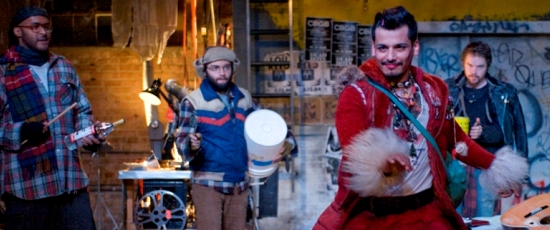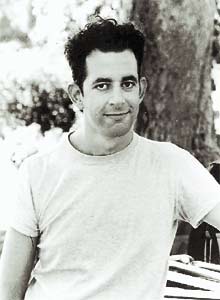ATC and About Face hang fresh ‘Rent’ sign on a production of street-level intimacy, energy
 Review: “Rent” by Jonathan Larson at American Theater Co. in collaboration with About Face Theatre, through July 1. ****
Review: “Rent” by Jonathan Larson at American Theater Co. in collaboration with About Face Theatre, through July 1. ****
By Nancy Malitz
During its 12-year Broadway run, “Rent” survived numerous cast changes in 5,123 performances and became set in its groove. What a singular thing it is, then, to witness this musical become new again.
That’s what’s going on with director David Cromer’s intimate version of Jonathan Larson’s “Rent” now playing at American Theater Co. in collaboration with About Face Theatre. This is an ambitious production that puts you at street-level and bedside, so close you are practically inside the heads of Roger and Mark, the musician and the videographer, whose art seems to emerge spontaneously from what they’re observing and feeling.
 The hardship of being destitute and freezing and yet defiant in spirit, artistically uncompromising and looking for love — even in the face of death — is a formula that’s been around awhile. Puccini honed it to perfection with his opera “La bohème,” which debuted a hundred years before “Rent,” about starving young bohemians living by their wits in Paris when tuberculosis was the killer.
The hardship of being destitute and freezing and yet defiant in spirit, artistically uncompromising and looking for love — even in the face of death — is a formula that’s been around awhile. Puccini honed it to perfection with his opera “La bohème,” which debuted a hundred years before “Rent,” about starving young bohemians living by their wits in Paris when tuberculosis was the killer.
In “Rent,” Larson crafted a 1996 AIDS-era counterpart to Puccini’s 1896 opera, and Larson’s main characters are a slightly re-stirred mix of Puccini’s Rodolfo the poet, Marcello the painter, Schaunard the musician, Colline the philosopher, Mimi the TB-infected seamstress, Musetta the devastatingly beautiful singer, Alcindoro the sugar-daddy to Musetta, and Benoît the dreaded landlord.
Thus we have Roger Davis the HIV-infected songwriter, Mark Cohen the filmmaker, Angel Dumott Schunard the drag queen drummer, Tom Collins the gay anarchist, Mimi Márquez the HIV-infected club dancer and drug addict, Maureen Johnson the devastatingly beautiful performance artist, Joanne Jefferson the lawyerly bankroll to Maureen, and Benjamin “Benny” Coffin III the former buddy now dreaded landlord.
 Larson adds a chorus of additional players who take various small parts in addition to gathering together as an AIDS life support group to sing one of the musical’s most haunting numbers, “Will I (lose my dignity)?” Larson also preserves several scenes from “La bohème” as well as the opera’s wistful sentiment and urgency, while giving the story a harder edge for our own time. Mimi comes on to Roger more aggressively than Mimi did to Rodolfo, for example, but the “light my candle” sequence is shaped much the same.
Larson adds a chorus of additional players who take various small parts in addition to gathering together as an AIDS life support group to sing one of the musical’s most haunting numbers, “Will I (lose my dignity)?” Larson also preserves several scenes from “La bohème” as well as the opera’s wistful sentiment and urgency, while giving the story a harder edge for our own time. Mimi comes on to Roger more aggressively than Mimi did to Rodolfo, for example, but the “light my candle” sequence is shaped much the same.
Musically, Larson’s score is a stunning achievement, with nary a song that is weak. In this excellence it honors Puccini most of all. What a relief, in the ATC’s tiny space, to hear a quartet of ebullient bandmembers led by conductor/pianist Timothy Splain, clearly a superb musician, keeping a lid on the sound. They lent an ear to the show’s more deeply felt private moments and gentler insights, and there were many. The Broadway production of “Rent” took the volume to a din and favored belters, some of them truly great singers indeed. But the welcome closeness of Cromer’s production harkens back to “Rent’s” off-Broadway roots in a 150-seat theater, and it has its own rewards.
 One example finds Derrick Trumbly, as Roger, noodling with his psychological demons in tense near-quiet as he fingers his guitar and almost mutters rather than sings, eventually erupting in exasperated determination to force out that one great song before he … well, you’re right there in the room to finish the painful sentence for him. I’ve heard “Glory” more heroically sung, but Trumbly imbues the scene with his own touching authenticity.
One example finds Derrick Trumbly, as Roger, noodling with his psychological demons in tense near-quiet as he fingers his guitar and almost mutters rather than sings, eventually erupting in exasperated determination to force out that one great song before he … well, you’re right there in the room to finish the painful sentence for him. I’ve heard “Glory” more heroically sung, but Trumbly imbues the scene with his own touching authenticity.
Similar close-up insights abound in that small rectangular room, flanked on the two long sides by just a few rows of seats, a long strip of stage running down the middle. Mark, played by Alan Schmuckler as the true artist of the bunch, is always observing, ever vigilant, faithful ultimately only to his camera. You can almost see him keeping a portion of his mind at a distance. A beggar woman (Karla L. Beard) makes it clear she won’t be used by Mark’s lens — a memorable moment when you can meet that confrontation eye-to-eye. As the sweet-tempered honey Angel (played by Esteban Andres Cruz) seduces Tom (Alex Agard), he is amusingly undone. Grace Gealey is a full-throated Mimi of outward confidence and animal energy, betrayed by subtle flickers of increasing desperation as her addiction refuses to be conquered.
 Maureen’s performance art piece (sung by Aileen May) seems to lose impact in the cramped space, although May does break up the audience with her off-hand asides. And the collective moo-ing she elicits is, well, over the moon. Lighting for her act (designed by Heather Gilbert) makes clever use of handheld spots. And the costume that David Hyman came up with for her was hilarious, from cow hat to one udderly outrageous accessory.
Maureen’s performance art piece (sung by Aileen May) seems to lose impact in the cramped space, although May does break up the audience with her off-hand asides. And the collective moo-ing she elicits is, well, over the moon. Lighting for her act (designed by Heather Gilbert) makes clever use of handheld spots. And the costume that David Hyman came up with for her was hilarious, from cow hat to one udderly outrageous accessory.
Cromer keeps the action rolling in and out, from one side to another, occasionally maintaining a lively three-ring circus of activity as loft, support group and street scene compete for attention. Not to suggest the scenes are crowded. There is plenty of room for the love duet between Collins and Angel as they glide around a la Astaire & Rogers with shopping cart. Agard, who is a gifted baritone, plays Collins with sweatered charm. Meanwhile Cruz, as his bearded Angel, endows their number with enough kooky balletic grace for them both.
 The stage area seems to expand during such set pieces, including the delicious “Tango Maureen,” in which Mark and Joanne realize that their shared bewitcher has ignited in them a mutual need for gnashing of teeth and violence of footwork. Lili-Anne Brown, in full command of her vocal chops, actually makes the lawyer Joanne a sympathetic character. Choreographer Jessica Redish holds interest throughout, including an evocation of Angel’s death throes that might have been haunting, had there been enough light to see it on opening night.
The stage area seems to expand during such set pieces, including the delicious “Tango Maureen,” in which Mark and Joanne realize that their shared bewitcher has ignited in them a mutual need for gnashing of teeth and violence of footwork. Lili-Anne Brown, in full command of her vocal chops, actually makes the lawyer Joanne a sympathetic character. Choreographer Jessica Redish holds interest throughout, including an evocation of Angel’s death throes that might have been haunting, had there been enough light to see it on opening night.
Scenic designer Collette Pollard stashes the loft space shared by Mark and Roger at one end of the stage area, its most distinctive feature a fabulous motley array of electrical wire snaking up the wall. I don’t even want to think about the task of cataloguing all the re-purposed junk her design requires, but in a single stroke she captures the essential state of the artists’ rumpled life amid mountainous piles of gear, garbage and bed clothes.
The loft is where Roger and Mimi first meet, and if their relationship grows slowly at first, it’s in part because they know the only safe sex is with someone else who’s doomed. At the last, though, their outlook as a couple actually seems to outshine that of their 19th century counterparts. It figures. They have two of the best love songs written at the end of the millennium. Larson must have been on their side all along.
Related Links:
- The Seven-Year Odyssey That Led to Rent: Read Anthony Tommasini at nytimes.com
- Original Broadway cast recording (1996): Find it online
- Performance location, dates and times: Go to TheatreinChicago.com
Photo credits and captions: Home page and top: Angel (Esteban Andres Cruz in foreground) dances for Tom Collins (Alex Agard), Mark Cohen (Alan Schmuckler ) and Roger Davis (Derrick Trumbly). Descending: Roger (Derrick Trumbly) tries to write one last song as Mark (Alan Schmuckler) looks on. “Rent” composer Jonathan Larson. Videographer Mark (Alan Schmuckler) captures a street scene. Maureen Johnson (Aileen May) wants the crowd to go over the moon. Director David Cromer. (Production photos by Mark Brosilow)
Tags: About Face Theatre, Aileen May, Alan Schmuckler, Alex Agard, American Theater Co., American Theater Company, Collette Pollard, David Cromer, David Hyman, Derrick Trumbly, Esteban Andres Cruz, Grace Gealy, Heather Gilbert, Jessica Redish, Jonathan Larson, Karla Beard, Lili-Anne Brown, Rent, Tim Splain


No Comment »
1 Pingbacks »
[…] Review of “Rent” at ATC: Read it at ChicagoOntheAisle.com […]